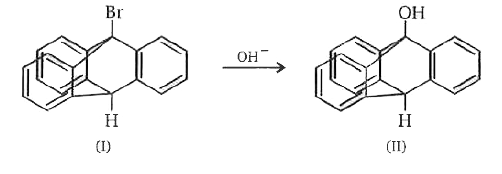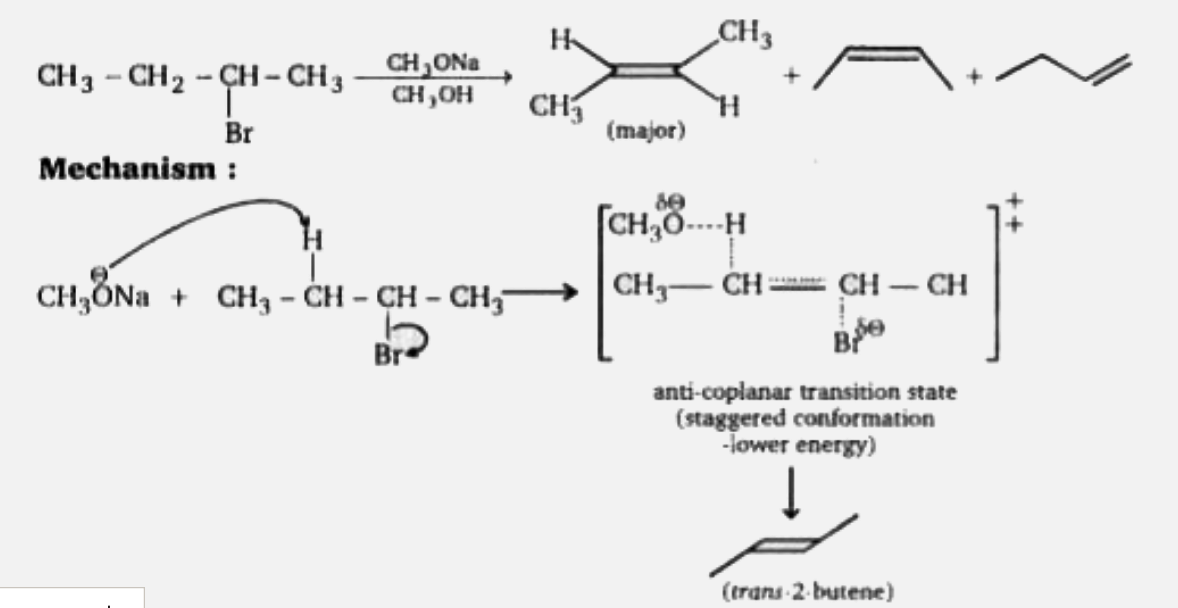 Conversion of I to II :Solution in Telugu
Conversion of I to II :Solution in Telugu
takes place by S1N
takes place by S2N
takes place both by S1N and S2N
does not take place
The correct Answer is:D
In - 1 bromotriptycener,

The bromine atom is found to be virtually inert to nucleophilies. Despite the formal resemblance in the environment ofthe bromine atomin to thatin, they are found to differ in their rate ofreaction under parallel conditions by a factor of ≈10−23 : 1 ! This is bacause stabilisation ofthe carbocation in en can occur bydelocalisation ofits charge through the π− orbital systems ofthe three benzene rings, whereas the extremelyrigid structure of (ll) will hold the cation.s emptyorbital (from loss of BrΘ but a right angles to these π -orbital systems, thus preventing such delocalisation.
Topper's Solved these Questions
- BOOK - MS CHOUHANCHAPTER - ALKYL HALIDES (SUBSTITUTION REACTIONS)EXERCISE - LEVEL-241videos
ALKYL HALIDES (SUBSTITUTION REACTIONS)
- BOOK - MS CHOUHANCHAPTER - ALKYL HALIDES (ELIMINATION REACTION) EXERCISE - LEVEL-225videos
ALKYL HALIDES (ELIMINATION REACTION)
- BOOK - MS CHOUHANCHAPTER - AMINESEXERCISE - Level-21videos
AMINES
Similar Questions
The order of the nucleophilicity of F−,Cl−,Br−andI− in protic solvents is
05:42View SolutionComprehension
E2 raction → Elimination bimolecular
In the general mechanism of the E2 reaction a strong base abstract a proton on a carbon atom adjacent to the one of the leaving group. As the abstracts a proton , a double bond forms and the leaving group leaves.

Identify the rate ofreaction of given compounds in E2 reaction:
 03:35View Solution
03:35View SolutionFive amine syntheses are outlined below. In each reaction box enter a single letter designating the best reagent and conditions selected from the list at the bottom of the page.

 05:44View Solution
05:44View SolutionConversion of coordinates in Polar conversion form:(i) Convert the following Cartesian coordinates to the corresponding polar coordinates using positive r and negative r . (i)(-1;1) (ii) (2;-3)
01:19View SolutionConsider the pathway of a well known organic reaction

For the conversion from I to II, which reagent was used?01:21View SolutionWrite following conversions (i) Nitrobenzene-Acetanilide (ii) Acetanilide-p-nitroaniline
03:31View SolutionName the term used for the following :
(i) Conversion of vapours to solid (ii) Conversion of solid to liquid (iii) Conversion of vapours to liquid.02:48View SolutionHow will you carry out the following conversions :
(i) 2-Bromopropane to 1-bromopropane
(ii) Benzene to p-chloronitrobenzene05:44View SolutionMatch the chemical conversions in Column I with the appropriate reagents in Column II.
02:30View Solutionनिम्न ऊर्जा रूपांतरणों के उदाहरण कीजिये :
(i) विद्युत ऊर्जा का यांत्रिक ऊर्जा में रूपान्तरण
(ii ) यांत्रिक ऊर्जा का विद्युत ऊर्जा में रूपान्तरण09:19View SolutionWrite following conversions: (i) nitrobenzene to acetanilide (ii) acetnilide to p-nitroaniline.
04:21View SolutionDo the following conversions in not more than two steps. (i) Benzoic acid to Benzalolehyde (ii) Propanone to propene.
View Solutionপ্রাথমিক (i)সারি রুপান্তরসমূহ এবং (ii)স্তম্ভ রুপান্তরসমূহ প্রয়োগ করে A=⎡⎢⎣15002−1103⎤⎥⎦ ম্যাট্রিক্সের বিপরীত ম্যাট্রিক্স নির্নয় করো।
03:38View SolutionCarry out the following conversions in not more than 2 steps:
(i)Aniline to chlorobenzene
(ii)2-bromopropane to 1- bromopropane02:07View SolutionHow will you bring about the following conversions :
(i) Ethanoic acid to ethanol
(ii) Ethanol to ethanal ?03:22View Solutionमृदीय नाइट्रेट्स की स्वतंत्र N, में परिवर्तन की प्रक्रिया __(I)__ कहलाती है तथा यह __(II)__ बैक्टीरिया द्वारा सम्पन्न की जाती है।
04:33View Solution
